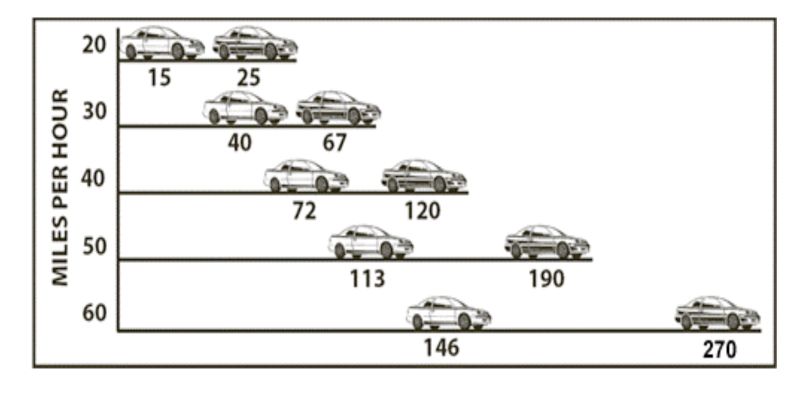Florida Driver Handbook: Equipment Standards
Order now7. Vehicle Equipment
- 7.1. Equipment Standards
- 7.2. Other Equipment Standards
- 7.3. Equipment Not Permitted
- 7.4. Additional Equipment Required on Certain Vehicles
- 7.5. Limitations on Towing
- 7.6. Limitations on Loading; Securing the Load
- 7.7. Projecting Load
- 7.8. Anti-Locking Brake System (ABS)
- 7.9. Emissions - Please Do Not Tamper
- 7.10. Vehicle Licensing
- 7.11. Proving Ownership and Insurance Coverage
- 7.12. Applying For Title, License Plates and Registration
The equipment on your car must meet certain standards. These are listed below.
7.1.1 - Brakes
Your car must have two braking systems. Each must be able to stop the car alone. The parking or emergency brake should be strong enough to hold the car on any hill. Your brakes must be able to stop your car within the distance shown on the chart.
7.1.2 - Braking Distance

Perception distance is how far your vehicle travels, in ideal conditions; from the time your eyes see a hazard until your brain recognizes it. Keep in mind certain mental and physical conditions can affect your perception distance. It can be affected greatly depending on visibility and the hazard itself. The average perception time for an alert driver is 3?4 second to 1 second.
Reaction distance is how far you will continue to travel, in ideal conditions; before you physically hit the brakes, in response to a hazard seen ahead. The average driver has a reaction time of 3?4 second to 1 second. At 50 mph this accounts for 55 feet traveled.
Braking distance is how far your vehicle will travel, in ideal conditions; while you are braking. At 50 mph on dry pavement with good brakes, it can take about 158 feet.
Total stopping distance is the total minimum distance your vehicle has traveled, in ideal conditions; with everything considered, including perception distance, reaction distance and braking distance, until you can bring your vehicle to a complete stop. At 50 mph, your vehicle will travel a minimum of 268 feet.
The faster you drive the greater the impact or striking power of your vehicle. When you double your speed from 20 to 40 mph the impact is 4 times greater. The braking distance is also 4 times longer. Triple the speed from 20 to 60 mph and the impact and braking distance is 9 times greater. At 60 mph, your stopping distance is greater than that of a football field. Increase the speed to 80 mph and the impact and braking distance are 16 times greater than at 20 mph. High speeds greatly increase the severity of crashes and stopping distances. By slowing down, you can reduce braking distance.
You need to stay alert while driving to be able to stop while giving other drivers time to slow down. Stopping suddenly is dangerous and usually means you are not paying attention to the traffic flow or following others too closely. Sudden slow downs make it harder for drivers behind your vehicle to stop without causing a collision.
If moving to the curb to stop your vehicle, check mirrors for traffic to the rear, check over your shoulder and signal intention. Release accelerator to allow vehicle to slow, pivot your foot to the brake pedal and press brake pedal with steady pressure for a smooth stop, move to within 12 inches of the curb. If stopping at a stop sign or traffic signal light, stop behind the stop line or crosswalk as appropriate.
If you have a vehicle with manual transmission, always slow down using the brake pedal first before pressing down the clutch. Brake to a smooth stop then shift into first or the proper gear when stopped.
7.1.3 - Steering lock Operation
Vehicles have various systems used to remove the keys from the ignition. Here are some common steering wheel lock systems and a description of how to remove the key:
The "Transmission Park" System
Shift the transmission into the "park" position. Turn the key to LOCK and remove.
The "Two Hand Button" System
This system requires two hands. Depress button below the steering column. Turn key to the LOCK and remove.
The "Lever" System
Depress lever located near the ignition. Turn key to LOCK and remove.
The "One Hand Button" System
Depress button located near the ignition. Turn key to LOCK and remove.
The "Push In" System
Turn key OFF, push in. Turn key to LOCK and remove.
The "Turn and Remove" System Turn key to LOCK and remove.
7.1.4 Lights
Your car must have the following lights:
- Bright (high-beam) headlights which show objects 450 feet ahead.
- Dimmed (low-beam) headlights which show objects 150 feet ahead.
- Two red taillights mounted on the rear, visible from 1,000 feet.
- A white light that makes the license plate visible from 50 feet (The plate must be kept clean).
- Two red stoplights. They must be seen from 300 feet in the daytime, and must come on when the foot brake is pressed.
All vehicles, including animal-drawn vehicles, must have at least one white light visible from a distance of not less than 1,000 feet to the front. They must also have two red lights visible from a distance of not less than 1,000 feet to the rear, or one red light visible to the rear for a distance of 1,000 feet and two red reflectors visible from all distances from 600 feet to 1,000 feet.
Check out our Customer Reviews!


